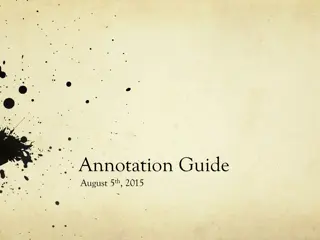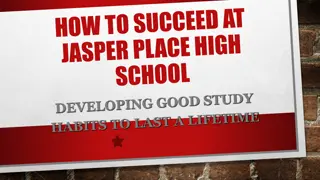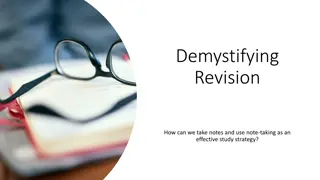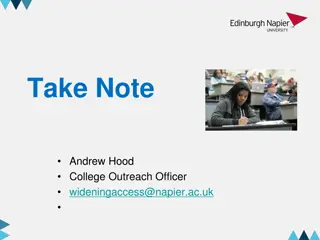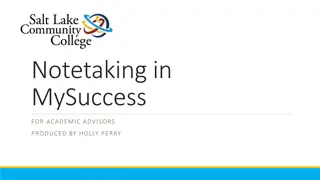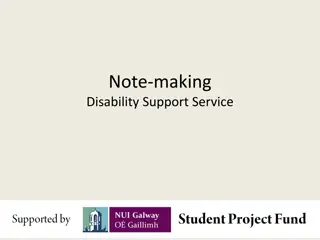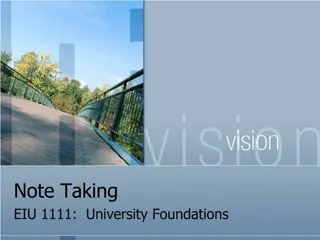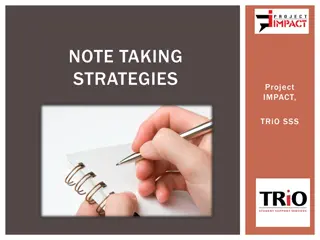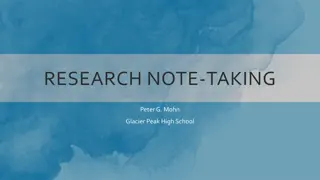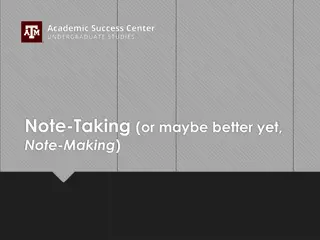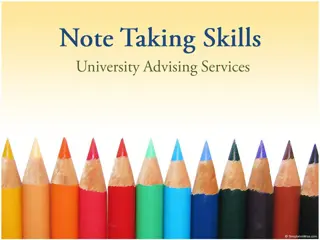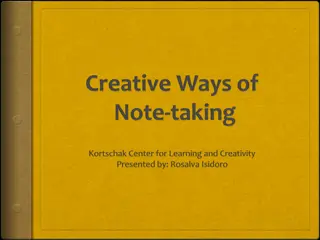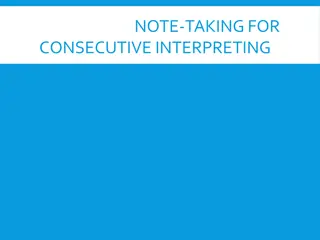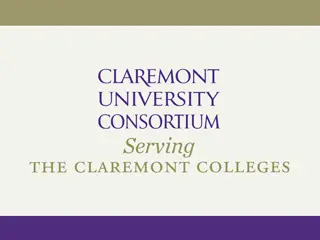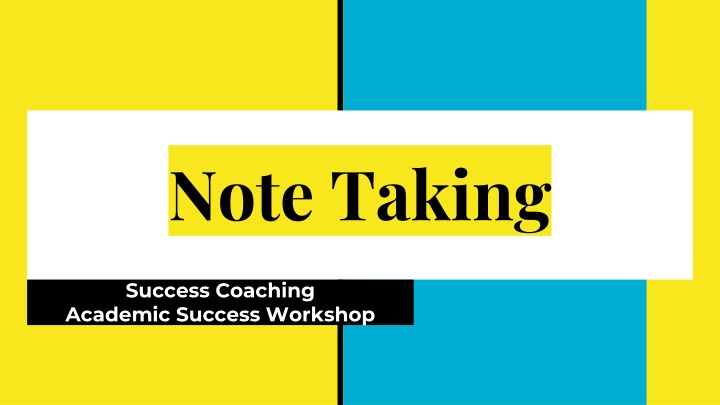
Effective Note-Taking Strategies for Academic Success
Discover the importance and benefits of effective note-taking, various methods such as the Cornell Method, different ways to take notes, and helpful tools for both traditional and digital notes. Learn how to take notes effectively to enhance your understanding and retention of information.
Download Presentation

Please find below an Image/Link to download the presentation.
The content on the website is provided AS IS for your information and personal use only. It may not be sold, licensed, or shared on other websites without obtaining consent from the author. If you encounter any issues during the download, it is possible that the publisher has removed the file from their server.
You are allowed to download the files provided on this website for personal or commercial use, subject to the condition that they are used lawfully. All files are the property of their respective owners.
The content on the website is provided AS IS for your information and personal use only. It may not be sold, licensed, or shared on other websites without obtaining consent from the author.
E N D
Presentation Transcript
Note Taking Success Coaching Academic Success Workshop
Important and Benefits of Effective Note Taking Note-taking is crucial for academic success, why: It helps students actively engage with material Enhances your understanding and allows you to put things into your own words and include tips, drawings, and key words Benefits: Well organized notes help you review before quizzes & exams Taking notes helps you retain the information Taking notes allows you to develop critical thinking skills about the information at hand (ie. what are the main ideas), this helps enhance your understanding
Ways to Take Notes The Cornell Method - cue column, thoughts column, summary beneath Good for -> Auditory learners Outlines - hierarchical method (main topic, sub topic, supporting details) Good for -> Organizing a lot of information and creating study guides Concept Mapping - drawing connections between ideas using visual aids Good for -> Visual learners and complex ideas Sentence Method - writing down each idea on a new line Good for -> Fast paced lectures and lessons Typing vs Writing Typing -> tends to be faster, can turn your notes into other digital study aids (ex. quizlet) Writing -> best way to solidify information in your brain and develop recall; best for math and science notes (often require diagrams and drawing)
Note Taking Tools Traditional Handwritten Notes Notebook, pens, highlighters, rulers Make sure to keep notes legible, organized, and in their place Digital Notes Google Drive - create folders for each class, docs for notes and study guides OneNote - Microsoft Office s notebook platform, allows you to add tabs and pages, college ruled lines or graph paper, syncs with other Office Suite apps Make sure to keep notes for each class organized and not in one giant doc
How to Take Notes Effectively 1. Take notes in your own words and focus on the main points and idea. Avoid writing down everything verbatim. 2. Actively listen and jot down important points rather than passively listening to copy notes 3. Stay organized: Keep your notes for each subject in a separate binder, folder, or notebook. For digital notes, create folders and subfolders for different topics, lectures, or readings. 4. Use visual aids: headings and titles and colors 5. Review, rewrite, or retype your notes.
Clues to Look Out For Professors sometimes give hints as to what information you should focus on 1. Verbal clues like repeated ideas and emphasis words. Pay attention to emphasis phrases like: This is important..." "Key point..." "Remember this..." "Let me clarify..." Visual clues: Writing on the board Underlining or circling Bolded on slides 1.
Best Practices for Visual Learners Note Taking When taking notes, use different fonts/colors/highlighters/etc. Include diagrams or mind maps to show intricacies of a concept Studying Watch videos to refresh Utilize techniques like whiteboarding, mind mapping, and drawing Use color and visual aids to help you recall information more effectively
Best Practices for Auditory Learners Note Taking Write or type only the important parts that you want to ensure you remember Record lectures Studying Say out loud to another person (or yourself) all the information you need to know Re-watch lectures or other videos Transcribe recordings to get in the habit of repetition
Best Practices for Tactile Learners Note Taking Consider handwriting notes to keep your hands busy Taking time to write your notes out by hand can help to remember what you have done rather than saw or heard Studying Move around and use activities Game-ifying your notes Studying while: walking on a treadmill, listening to a lecture/youtube video while you work out, etc.
Use Your Resources If you are unsure where to start, ask for assistance Visit your professor s office hours and ask questions, what should you be focusing on? How have past students been successful? Use your resources, you can find many offices on campus that give out notebooks, flashcards, pens, or can help you learn to use a digital platform Utilize resources like Success Coaching, The LARC, The OEA, Peer tutoring, Library Resources, and more Ask other students in the class how they organize their notes
Thank You! To receive more individualized Note Taking Assistance, Schedule an appointment with a Success Coach! 220 Lawrence Center Phone: (610) 436-1067 Email: successcoaching@wcupa.edu




